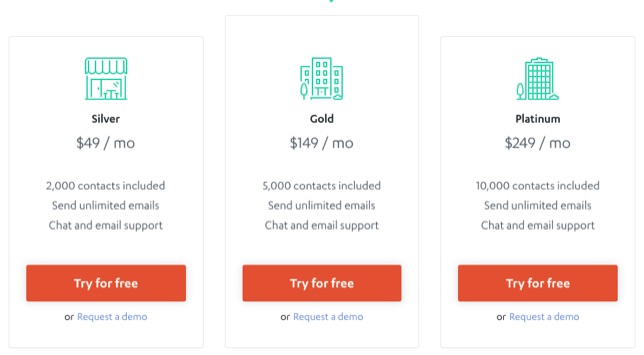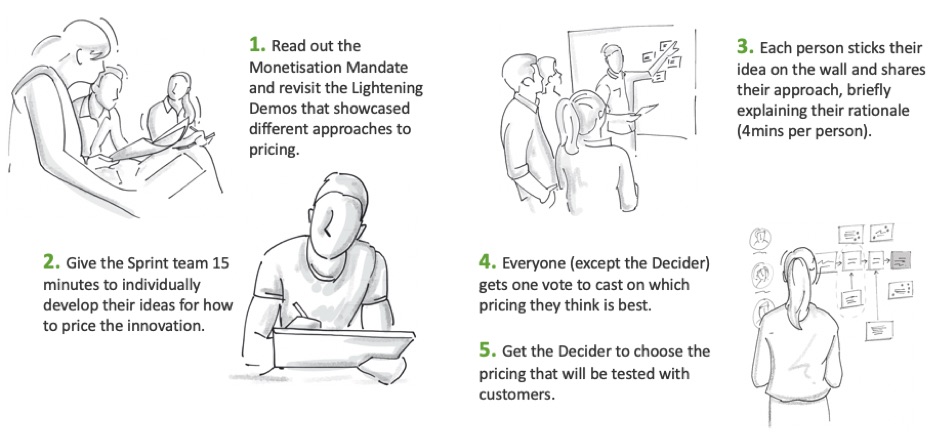
This guide was prepared by Jenny Millar (Untapped) for innovationtraining.org.
Companies pour billions of dollars into designing and building products and services, yet frequently struggle to monetize them. 72% of innovations fail to meet their financial targets or fail entirely.
Price is such an integral part of product design yet is often overlooked until an MVP has been fully formed and perhaps even road-tested. Organisations posing the ‘How much will customers be willing to pay’ question too late in the product development journey have come to accept the resulting failure rate as the cost of doing business.
Yet radically improving the odds that your innovation will succeed is just a matter of removing the pricing guesswork. Incorporating price into a Design Sprint will ensure your product and how it is priced are designed in lockstep from the beginning.
Before the Sprint
When to integrate pricing into a Design Sprint

The Design Sprint is a battle-tested process for answering critical business questions through design, prototyping, and testing ideas with customers. Originally a 5 days process born from Google Ventures, the Design Sprint 2.0 has been compressed to 4 days using countless little hacks to make the process even more efficient.
The Sprint gives you a superpower: to rapidly validate new ideas with customers before investing time and money to build them. Any Design Sprint involving onboarding or purchase journeys warrants the adaptations laid out below. User-testing a commercial innovation without examining willingness to pay creates a glaring hole in the validation process. Follow these simple steps to ensure your product and its price are designed in tandem, drastically reducing the risk of commercial failure when it’s out in the wild.
Your Sprint challenge should be:
- Big enough to have sizeable financial goals associated with it
- Costly enough if it doesn’t go well and is worth validating quickly
- Something that involves a customer making a decision to buy, try or refer a product or service
Good examples:
- Problems with conversion for a particular product
- Thinking about adding a subscription service to an existing product
- Creating a brand new product
Preparation & research
Before the Sprint, assemble a Monetisation Mandate for the challenge being addressed. This may require the involvement of a different set of internal stakeholders to the Sprint team. Here are 6 key questions to elicit the information you’ll need:
- What are the financial expectations of addressing the Sprint challenge?
- What customer behaviours is this expected to drive?
- When and how will performance will be evaluated?
- What is the appetite for risk?
- Who is responsible for financial performance?
- Are there any specific pricing-related expectations to be aware of (eg. MRR)?

Day 1
Expert Interviews
The individual who is accountable for the commercial success of the Sprint initiative joins the expert interviews. They relay the financial expectations previously clarified in the Monetisation Mandate before the Sprint.
Lightning Demos
There are a raft of pricing mechanisms and price-framing techniques that support different goals.
Use Lightning Demos to showcase these in action. Here’s a ready-made list of examples:
- Rapid user growth: Include a Free Option or Free Trial
- Boosting profitability and recurring revenues: Tiered subscription plans
- Demystifying complex pricing: Pricing slider
- Nudge buying behaviours: Recommended plan (to signpost users), Price anchoring (to influence price perception) or Scarcity tactics (to increase urgency)

Encourage the Sprint team to observe the language used in your pricing examples. How does the wording convey the value of what’s on offer? Are there strong calls-to-action being used? What does the pricing page tell you about what the company wants their customers to do?
Two invaluable resources for browsing example pricing pages in one place are Inspire and Mobbin.
Day 2
Storyboarding
One of your pages on the Storyboard needs to be dedicated to the moment that a purchase decision is made. This could mean the selection of a subscription tier or simply the decision to checkout or not.
If the 3-part concepts contained multiple approaches to pricing (or if none of them included pricing), an additional exercise can be run before Storyboarding to help the Sprint team decide what to test.

Day 3 is Prototyping
Day 4
User Testing

Unprompted clues
During the customer interviews, watch out for unprompted comments about the pricing or clues to how the price would influence a customer’s decision.
Pricing prompts
Avoid asking directly how much the customer is willing to pay as they’ll likely shade the truth. Instead, try asking some of the following questions to better understand how your customers think about the price:
- In what circumstances would you pay for this?
- What could encourage you to buy at this price?
- Who do you think might be willing to pay for this?
- Which are the most valuable element(s) to you?
- Which are the least valuable element(s) to you?
- Is this how you’d expect to be charged for something like this?
Having incorporated price into the Design Sprint, the team will leave with a more meaningful assessment of their idea having removed the pricing guesswork.
This guide was prepared by Jenny Millar (Untapped) for innovationtraining.org. Get in touch to find out how to introduce pricing in your own Design Sprints or find a facilitator. Contact us at [email protected].
